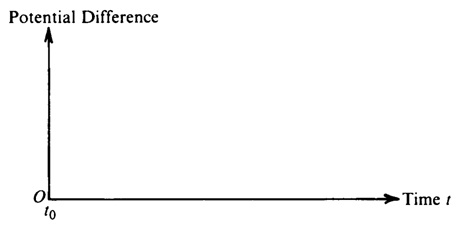Assignment:
Problem 1.
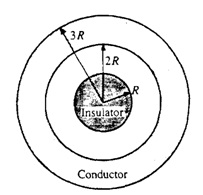
An insulator ball of radius R has a net charge of + Q distributed uniformly throughout its volume is floating in space. It is surrounded by a spherical metalshell of inner radius 2R and outer radius 3R, as shown in the sketch above. The spherical metal conducting shell contains a net charge + q different from the insulator ball's+ Q.
Use Gauss's law to figure out the electric field for the following values of r, which represents the distance from the center of the insulator ball. Answers should be in terms of R, r, Q, q, and/or ε0
a. 0 < r < R
b. R < r < 2R
c. 2R < r < 3R
Determine the surface charge density (charge per unit area) on
d. the inside surface of the metalconducting shell;
e. the outside surface of the metal conducting shell.
Problem 2. Find the currents I1 , I2 , I3 in the circuit diagram shown below . (I drew the directions of the currents below. There is a matrix program in the current folder if you need it)
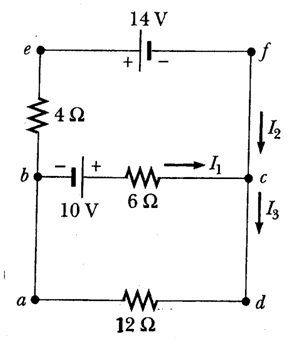
Problem 3. A long wire of linear mass density of μ = 0.0005 kg/m and tension T = 50 N is mechanically excited at a frequency of f = 10 Hz such that the transverse sinusoidal wave that is generated on the wire is described by:
y(x,t) = (0.01 m) sin [ 2π (x/λ - f t )]
a. In which direction is the sinusoidal wave propagating?
+X direction -X direction (circle one or delete the other)
b. Determine the wave propagation velocity, Vx (in m/s)
c. Determine the wavelength, λ(in m ) of the wave
d. Determine the angular frequency , ω (in rad/s) of the wave.
e. Determine the amplitude displacement, Ay ( in m) of the wave.
f. What is the maximum speed of vertical oscillation of a particle on this wire?
g. What is the vertical speed of a particle on the string at x=o and t=.14s
h. What is the maximum acceleration of a particle on this wire?
i. At what time t >o does this maximum acceleration occur for a particle located at the origin (x=0)
j. What is the vertical acceleration of a particle on the string at x=0 and t=.14s?
Problem 4. A candleis placed at position O which is 18 centimeters from the middle of a convex (converging) lens of focal length 6 centimeters as shown in the picture:
 lens.jpg)
a. On the illustration above, sketch a ray diagram to locate the Image. Draw an arrow that represents the image. (or redraw to the exact scale here)
b. Is the Image real or virtual? Explain your choice.
c. Using the lens equation, compute the distance of the image from the lens.
Second converging lens, also of focal length 6 centimeters is now placed 6 centimeters to the right of the original convex lens as shown in the picture below.
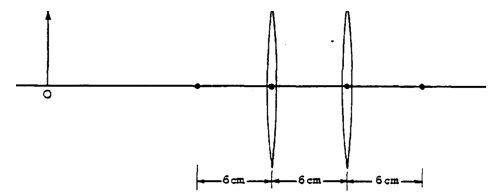
d. On the illustration above, (or drawn to scale below), sketch a ray diagram to locate the final image that now will be formed. Clearly indicate the final image.
Problem 5.
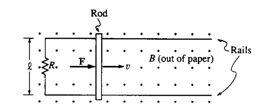
A rod made of metal has a force F applied to it so that the metal rod slides with a constant velocity v over a frictionless pair of parallel conducting rails that are separated by a distance l. The rod and rails don't have any resistance, but the rails are connected by a resistance R, as shown in the picture. There is a constant magnetic field B perpendicular to and directed out of the plane of the paper.
a. On the following picture, show with an arrow the direction of the induced current in the resistor.(1)Determine expressions for the following in terms of v, B, l, and R.

b. What is the induced emf in the rod
c. What is the induced current in the resistor R
d. Watt is the power dissipated in the resistor as the metal rod moves in the magnetic field
e. What is the magnitude of the external force F that is pulling on the rod to keep it moving with constant speed v(1)
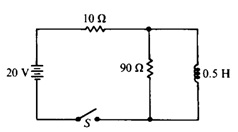
Problem 6. The picture above shows a circuit. Note that the switch S is initially open and all currents are initially zero. For t =0, immediately after the switch is closed, calculate each of the following.
a. The potential difference (voltage) across the 90 ohm resistor
b. The rate of change of current in the inductor
If the switch has remained closed for a long long time, now determine each of the following.
c. The current in the inductor
d. The energy stored in the inductor Later, at time to, the switch is reopened.
e. For the instant immediately after the switch is re-opened, find the potential difference across the 90 ohm resistor.
f. On the graph below, draw a line or curve representing of the potential difference across the 90 ohm resistor for t > to.
